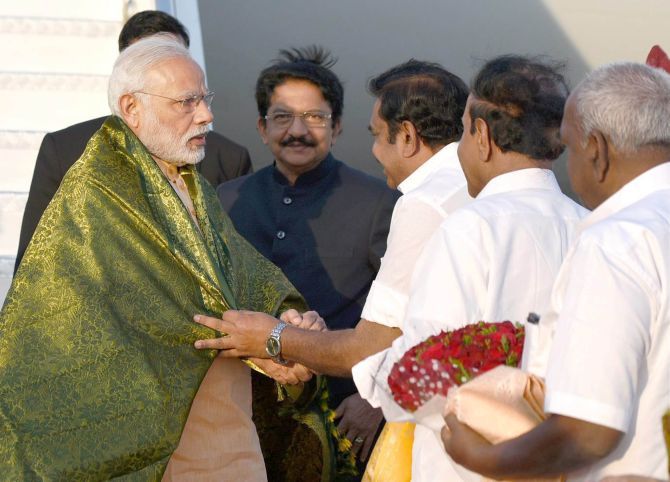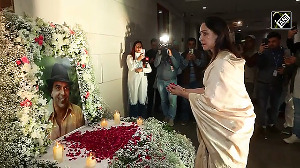It is no coincidence that the return of ‘Hindu nationalism’, packaged as ‘Hindutva nationalism’ has spawned the revival of ‘pan-Tamil nationalism’, both packaged in language and culture, with developmental aspects of contemporary politics and political economy providing the cover, says N Sathiya Moorthy.

Weeks after elections 2019, ‘insulated’ Tamil Nadu is still reeling under social media debate on ‘good nationalism’ and ‘bad nationalism’ -- or, ‘not-so-good nationalism’ -- possibly with greater vigour than earlier.
Lending grit to the mill is the argument if ‘pan-Tamil nationalism’ is back to the fore with greater vengeance -- and if it was good to the larger concept of Indian nationhood and statehood.
True -- and not true, or not-so-true. After decades of fading away, especially in electoral terms, pan-Tamil nationalism is back with a bang. That is to say, a new generation of Tamil youth in the country are ‘regaining’ the forgotten ‘Tamil consciousness’, which had been pushed to the background over an agenda of growth and development of the state, aspirations and achievements of the individual. Not anymore, it now seems.
The overall discourse is two-fold, or more. Primarily, the argument is that the revival of pan-Tamil nationalism, especially in the context of the forgotten/forgettable context of LTTE’s call for a ‘greater Eelam’, was a threat to Indian nationhood and state more than the original ‘Eelam’ cause was to neighbouring Sri Lanka.
The exit of the LTTE a decade ago has meant that the ‘Eelam cause’ was all but dead, despite Sri Lankan Tamil efforts to keep a ‘virtual Eelam’ alive through the ‘Trans-national Tamil Eelam’ (TGTE), with a virtual government with a prime minister and also a globally-elected virtual parliament.
The ‘greater Eelam’ cause was a non-starter even in the life of the LTTE and its leader Velupillai Prabhakaran. Though the LTTE was feeding a section of its youthful sympathisers in India (read: Tamil Nadu) with such ideas, in the aftermath of the Rajiv Gandhi assassination especially, the outfit was unwilling to irritate/antagonise India and Indians more than already.
It is against this background that the continuing revival of the original ‘pan-Tamil cause’ in India needs to be viewed. Though the original idea was confined to the Tamil-speaking areas of the erstwhile Madras Presidency in British India, 70-plus years after Indian Independence there is no guarantee anymore that the revivalist concept would not reach out to the Sri Lankan ‘Eelam cause’, which is otherwise rudderless and clueless despite pretences and protestations to the contrary.
The current controversies owe to the static north Indian understanding of ‘pan-Tamil nationalism’, rooting it all in the limited anti-Hindu, anti-god and anti-Brahmin aspects of the early day ‘Dravidian ideology’ that ruled the roost in the 20th century Tamil Nadu.
Truth be acknowledged, the revival of ‘Hindu nationalism’ packaged more vigorously -- and at times violently -- as ‘Hindutva nationalism’, can be said to be the cause of the recent revival of ‘pan-Tamil nationalism’, nothing more, nothing less.
Dating it back to the pre-Independence Madras Presidency, particularly the Tamil-speaking areas, ‘pan-Indian nationalism’ as understood at the time had in a way spawned the ‘Dravidian socio-political cause’, not the other way round -- as often misunderstood. If the Indian National Congress talked about the aspirations of, and opportunities for, Indians, the Dravidian political ideology, stratified the same, as became possible in the Madras Presidency of the twenties and thirties of the last century.
It is another matter that the ‘Justice Party’, as was/is known to date, was not founded or led exclusively by pan-Tamil, or even Tamil leaders of the time. The leadership for the cause was provided by prominent Telugu-speaking aristocrats and intellectuals dominating social and public life in the Presidency capital of Madras, now Chennai.
Even when the original Justice Party fell into disuse and misuse, especially unable to stand the politico-electoral avatar of the Congress, indirectly through the Swaraj Party in the twenties, and more directly in elections 1937, the new leadership came to be provided by ‘Periyar’ E V Ramaswami Naicker, or EVR, a Kannadiga by birth.
The parallels will become more visible when one considered the second edition of the Justice Party under Periyar, the birth of his Dravidar Kazhagam and the breakaway Dravida Munnetra Kazhagam, the latter born post-Independence, inching towards an electoral role that the former forbade his followers from -- as Gandhiji had urged fellow Congressmen, but to no avail.
Today’s linkages between ‘Hindutva nationalism’ and ‘pan-Tamil nationalism’ are nothing much different from the parallels in the pre-Independence era. At the time, there were those in the pre-Partition Muslim League who would dub the Congress as ‘the Hindu party’.
Yet, to the founders of the Hindu Mahasabha and the RSS, the Congress was not adequately Hindu. They rooted their arguments not just in politics or demography, but in language, culture and religion. It was in a way easy for the likes of Periyar to compare and contrast the emerging ‘religion-centric situation’ to create a new ‘pan-Tamil identity’, based on language and culture, caste and occupation.
Today, it is thus no coincidence that the return of ‘Hindu nationalism’, packaged as ‘Hindutva nationalism’ has spawned the revival of ‘pan-Tamil nationalism’, both packaged in language and culture, with developmental aspects of contemporary politics and political economy providing the cover -- or, is it the other way round?
The question being asked often is if the recent arrival of ‘environmental consciousness’ in Tamil society, that too to unacceptable levels that would only deny jobs and growths to the state and community, was not a part of ‘Tamil nationalism 2.0’.
It is not wholly untrue, nor can it be dismissed out of hand, either. But as a section of the Tamil social media has been arguing in recent times -- though not publicised enough -- it was the Swadesh Jagran Manch (SJM) of the RSS which had opposed ‘mindless growth’ of the ‘post-socialist’ Congress kind....
Now that the ‘Modi brand’ of Hindutva, mixing development and ‘cultural nationalism’ of the RSS kind, is here and successful, either the SJM has stopped bothering or has been sidelined from internal discourse. Or, so goes the pan-Tamil counter-narrative.
Does it mean that pan-Tamil nationalism Brand-2 too will die a natural death if and when growth and development actually reaches individual Tamil homes?
It had happened when electorally-relevant DMK took over from the DK, and if only over time, the latter’s ‘anti-god, anti-Hindu and anti-Brahmin’ ideologies, with Sanskrit/Hindi too as hate objects died a natural death.
It was similar to the death of ‘Hindutva 1.0’ with the advent of ‘Nehruvian socialism’, with assassination of Mahathma Gandhi providing political substance, early on.
If Gandhiji’s pre-and post-Partition ‘appeasement’ of Muslims was used to paint the Congress as ‘anti-Hindu’ in a limited constituency, the assassination ended up painting the RSS and the Mahasabha as ‘anti-nationals’.
It was not without reason that the exit of the religious identity of the Congress in these parts and its replacement with a ‘development agenda’ of the post-Independence Congress government, rendered the DK and Periyar ‘ideology’ less relevant than already.
If the DMK won the historic 1967 elections, it had nothing to do with religion or the ‘inherited Periyar ideology’, as is still misunderstood and/or mischievously propagated in pro-Hindutvacircles.
In 21st century India/Tamil Nadu, social media has been the main vehicle of all sides. It is a one-way discourse at best, and not an open-ended discussion, for anyone and everyone to get to have a holistic idea of issues and ideologies.
How then is ‘pan-Tamil nationalism 2.0’ relevant to 21st century India and more so ‘Dravidian’ Tamil Nadu? As long as pro-Hindutvaarguments are couched/covered in development and growth, environmental concerns and culture-centric issues like Jallikattu may have greater purchase than jobs and incomes.
After all, the larger Hindutva campaign is centred on religion and language (Sanskrit), culture and civilisation -- their age and antiquity, reach and depth.
In the Tamil Nadu context, the inability and/or unwillingness of these sections and their brethren elsewhere in the country, especially the national capital of Delhi, has propped up a counter-narrative, centred on the antiquity and richness of Tamil language and culture.
To add insult to injury is the Tamil perception and greater acceptance that Tamil has lived, survived and grown with time as possibly the only ancient language in continued usage to date -- against Sanskrit, or even Greek and Latin.
It is the perceived ‘step-motherly’ treatment that Tamil language and culture have purportedly got at the hands of Delhi’s ‘ruling elite’, now as earlier, that is finding different and diffident expressions in the form of revived opposition to everything North.
Thus, if there is a social media posting on the historic linkages of Sanskrit language or Indian culture to a European civilisation or population is doing the rounds on a ‘select circuit’, there is a parallel narrative similar linkages of Tamil language and culture, again confined to a ‘parallel circuit’.
If someone talks about the geography and geometry of some temple in Rajasthan or Uttar Pradesh, there is a parallel narrative on the science behind the construction of the Big Temple in Thanjavur, or the depth and width of the ancient ‘Siddha medicines’ of Tamil ascetics.
Given the ‘user-centric’ tools employed by social media providers, the twain seldom meets unless the user is in two different orbits and at the same time -- whatever be his interests and preferences.
What is different from the intra-culture war then and now is the fact that around the Independence era, they were all based in and out of the nation.
Today, call it the guilt of the larger NRI groups or the smaller NRT (Non-resident Tamil), and/or their prosperity, coupled with a yearning for what they had missed out during their growing up years back home that is feeding and funding competitive campaigns of the kind, addressing folks back home.
But in the era after elections 2019, when the pan-Hindutva lobby is getting stronger across the country, and also reflectively emboldened in ‘Dravidian’ Tamil Nadu, too, it remains to be seen how and how far would the other side act and/or react.
But then, in the post-Easter blasts weeks and months in neighbouring Sri Lanka, the need for greater circumspection seems to be missing in the words and deeds on both ends of the Palk Strait, even as a shriller pan-Tamil voice, provoked or otherwise, inside the country can reverberations elsewhere, including those of a ‘greater Eelam kind’, even if not here and now!
Is anyone out there, listening?
N Sathiya Moorthy, veteran journalist and political analyst, is director, Observer Research Foundation, Chennai Chapter.










